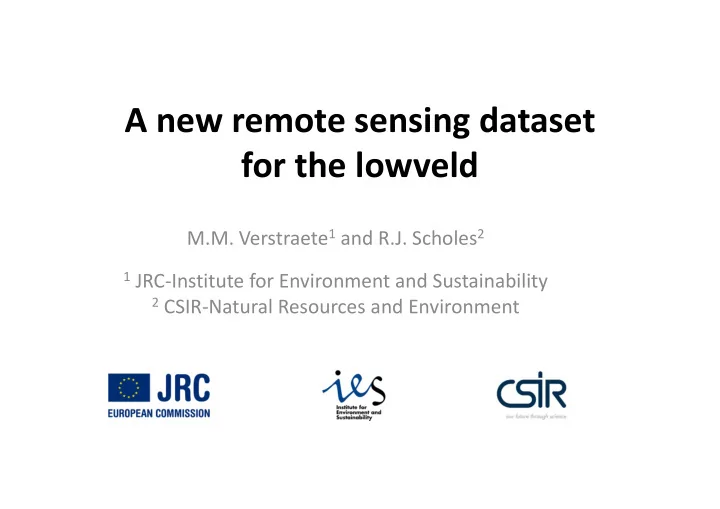

A new remote sensing dataset for the lowveld M.M. Verstraete 1 and R.J. Scholes 2 1 JRC-Institute for Environment and Sustainability 2 CSIR-Natural Resources and Environment
The MISR instrument Earth surface viewed at 9 angles Four spectral bands at each angle: 446 nm ± 21 nm 558 nm ± 15 nm Flight direction 672 nm ± 11 nm 866 nm ± 20 nm ~7 km/sec Da 70.5º 60.0º Ca <7 minutes to view each Ba 45.6º scene from all 9 angles Aa 26.1º 0.0º An Backward-viewing Backward-viewing Af 26.1º cameras cameras Bf 45.6º Nadir camera Nadir camera 60.0º Cf 70.5º Df Forward-viewing Forward-viewing cameras cameras
What is this thing called BRDF? Bidirectional Reflectance Distribution Function • Solar radiation is a highly directional source of light • Objects scatter incoming light differently in different directions, due to their intrinsic optical properties and overall geometric structure • BRDF models describe the anisotropy of the reflectance, given the illumination and observation directions • Imaging instruments observe reflected light in only one direction • Analysing measurements without accounting for anisotropy can lead to serious interpretation errors… • …but characterizing the anisotropy with multiangular measurements can provide information on the structure of the target… something savanna ecologists are very interested in
MISR data is a pain in the ar** MISR geo-location and angle-to-angle co-registration on SPACE OBLIQUE MERCATOR PROJECTION Space Oblique Mercator (SOM) projection “ P h y s i c a l ” M I S R i n s t r u m e n t I m a g e g r i d 9 a n g l e s x 4 b a n d s Space Oblique E a r t h s s u r f a c e ʼ Mercator projection 3 6 n o n - r e g i s t e r e d minimizes re- i m a g e s sampling distortions “ V i r t u a l ” M I S R i n s t r u m e n t 233 unique paths in 16-day repeat-cycle 3 6 c o - of Terra orbit 9 a n g l e s x 4 b a n d s r e g i s t e r e d i m a g e s W G S 8 4 e l l i p s o i d S O M g r i d 9 cameras, 4 bands, weird HDF format, awkward projection
A clever trick… • To save bandwidth, MISR only sends full resolution (275 m) radiances for the 4 bands at nadir, and the Red band at all other angles – The other bands are sent at 1.1 km resolution, except on special request • JRC algorithm reconstructs reflectances in all bands at all angles and generates downstream products (e.g., FAPAR, LAI) at full resolution • This is unique to MISR – other FAPAR sources are at 500 to 2500 m resolution
Approximate Local Mode coverage SANSA has the complete MISR archive for Africa east of Angola Path 169 Block 110
JRC RPV k parameter - bowl/bell shape of the anisotropy k parameter, red band, Path 169, Orbit 17591, Block 110 Basalt- Granite contrast k parameter, NIR band, Path 169, Orbit 17591, Block 110 Bowl Bell
Inversion working backwards through the model • If we knew the surface characteristics and the solar and observation angle, we could predict the photons reaching the satellite, using ray-tracing models • But we only know what the satellite sees, and the solar and view angles • If we have enough view angles we can work backwards to infer what the surface must be like E. Bourderes Pinty, B., T. Lavergne, R. E. Dickinson, J.-L. Widlowski, N. Gobron and M. M. Verstraete (2006) 'Simplifying the interaction of land surfaces with radiation for relating remote sensing products to climate models', Journal of Geophysical Research, 111, doi:1029/2005JD005952.
Two-stream inversion package JRC TIP Surface albedo (soil + vegetation) Surface albedo, VIS band, Path 169, Orbit 17591, Block 110 Surface albedo, NIR band, Path 169, Orbit 17591, Block 110
JRC TIP Fraction of Absorbed Photosynthetically Active Radiation (FAPAR) and LAI FAPAR, Path 169, Orbit 17591, Block 110 Good rains fell here LAI, Path 169, Orbit 17591, Block 110 Phalaborwa gypsum dumps FAPAR=0, LAI=0
Our goal: Detailed, long-term, accurate vegetation time-series
Summary • 275 m resolution products of 8 to 16-daily FAPAR, LAI, albedo and other surface parameters will soon be available for the lowveld, and later for all of Africa, for the decade 2000 to 2010+, • The accuracy and spatial resolution of the products is unrivalled • They have application especially in climate modelling, phenology, primary production modelling and change detection
Recommend
More recommend